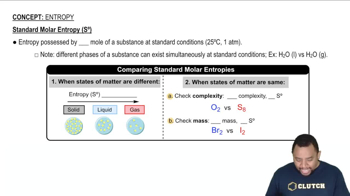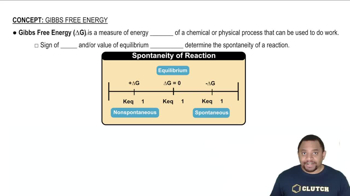Use data from Appendix IIB to calculate ΔS°rxn for each of the reactions. In each case, try to rationalize the sign of ΔS°rxn . b. C(s) + H2O(g) → CO(g) + H2(g)
Ch.19 - Free Energy & Thermodynamics

Chapter 19, Problem 55d
Use data from Appendix IIB to calculate ΔS°rxn for each of the reactions. In each case, try to rationalize the sign of ΔS°rxn. d. 2 H2S(g) + 3 O2(g) → 2 H2O(l) + 2 SO2(g)
 Verified step by step guidance
Verified step by step guidance1
Identify the standard entropy values (S°) for each reactant and product from Appendix IIB.
Write the balanced chemical equation: 2 H2S(g) + 3 O2(g) → 2 H2O(l) + 2 SO2(g).
Calculate the total standard entropy of the reactants: (2 * S°(H2S)) + (3 * S°(O2)).
Calculate the total standard entropy of the products: (2 * S°(H2O)) + (2 * S°(SO2)).
Determine the change in standard entropy (ΔS°rxn) using the formula: ΔS°rxn = ΣS°(products) - ΣS°(reactants).

Verified video answer for a similar problem:
This video solution was recommended by our tutors as helpful for the problem above.
Video duration:
3mWas this helpful?
Key Concepts
Here are the essential concepts you must grasp in order to answer the question correctly.
Standard Entropy (ΔS°)
Standard entropy (ΔS°) is a measure of the disorder or randomness in a system at standard conditions (1 atm, 25°C). It quantifies the amount of energy that is unavailable to do work due to the dispersal of energy among the particles in a substance. Higher entropy values indicate greater disorder, while lower values suggest more order.
Recommended video:
Guided course

Standard Molar Entropy
Entropy Change in Reactions
The change in entropy (ΔS°rxn) for a chemical reaction is calculated by considering the difference in standard entropies of the products and reactants. It is given by the equation ΔS°rxn = ΣS°(products) - ΣS°(reactants). A positive ΔS°rxn indicates an increase in disorder, while a negative value suggests a decrease in disorder during the reaction.
Recommended video:
Guided course

Entropy in Phase Changes
Rationalizing the Sign of ΔS°rxn
Rationalizing the sign of ΔS°rxn involves analyzing the physical states and the number of moles of reactants and products. Generally, reactions that produce gases from solids or liquids, or increase the number of gas molecules, tend to have a positive ΔS°rxn. Conversely, reactions that produce fewer gas molecules or convert gases to liquids or solids typically exhibit a negative ΔS°rxn.
Recommended video:
Guided course

Spontaneity of Reactions
Related Practice
Textbook Question
Textbook Question
Use data from Appendix IIB to calculate ΔS°rxn for each of the reactions. In each case, try to rationalize the sign of ΔS°rxn. c. CO(g) + H2O(g) → H2(g) + CO2(g)
Textbook Question
Use data from Appendix IIB to calculate ΔS°rxn for each of the reactions. In each case, try to rationalize the sign of ΔS°rxn . a. 3 NO2(g) + H2O(l) → 2 HNO3(aq) + NO(g)
Textbook Question
Use data from Appendix IIB to calculate ΔS°rxn for each of the reactions. In each case, try to rationalize the sign of ΔS°rxn. b. Cr2O3(s) + 3 CO(g) → 2 Cr(s) + 3 CO2(g)
Textbook Question
Use data from Appendix IIB to calculate ΔS°rxn for each of the reactions. In each case, try to rationalize the sign of ΔS°rxn. c. SO2(g) + 1/2 O2(g) → SO3(g)
